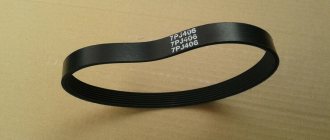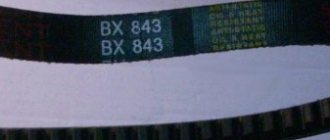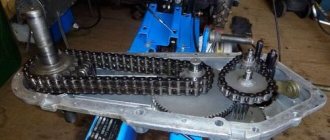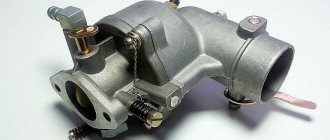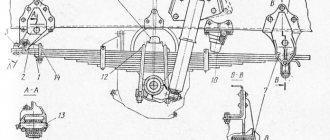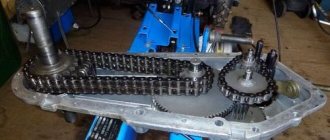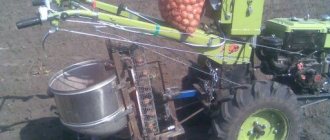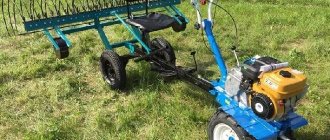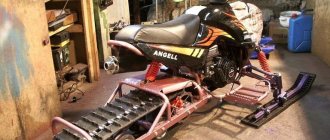An indispensable assistant not only for people professionally engaged in agriculture, but also for owners of summer cottages, small agricultural lands, and farms is the OKA - MB-1 walk-behind tractor. Being a universal mechanical device, the functions of the walk-behind tractor are not limited solely to plowing and plowing the soil. The unit is also used for the following purposes:
- hay preparation;
- mowing grass;
- mechanical cleaning of sidewalks and paths in personal plots;
- transportation of small cargo;
- snow removal.
This device is multifunctional
Advantages of Oka walk-behind tractors
The Oka walk-behind tractor is a serious piece of equipment for real professionals; it is designed to perform a range of work on the ground, in a summer cottage, and can be used as a mini snow blower in combination with special attachments.
The main advantages of Oka walk-behind tractors that made them so popular among farmers and summer residents:
- economical, low noise engines
- reaches a speed of 10 km/h with a trailer;
- small size (disassembled equipment can be transported even in the trunk of a car);
- the ability to cultivate not only well-groomed soils, but also virgin lands;
- multifunctionality (used for watering, cleaning, transportation, etc.).
The walk-behind tractor is equipped with a four-stroke engine, gearbox, steering wheel, clutch and two wheels. Instead of wheels, four cutters can be installed on the walk-behind tractor for cultivating the soil.
Features of the Neva walk-behind tractors
There are many modifications of this walk-behind tractor (MB-2, MB-23, etc.). Each device has its own type of belt. Mostly MB-1 walk-behind tractors are used - motor-cultivators of the old modification. It should be noted that the operation of the MB-1 and MB-2 devices is based on a V-belt transmission mechanism. This system ensures that the unit moves forward and backward, respectively; without its help, the device simply will not work. Motoblocks of the MB-1 modification have a built-in V-belt transmission for both strokes. In MB-2 editions, only one forward gear is used. Based on this, in order to choose a belt for the Neva walk-behind tractor, you should stock up on the following data:
- you need to know the type of belt that matches your specific unit model;
- belt length;
- degree of tension of the part;
- type of V-belt transmission (for certain modifications).
Engine
Depending on the modification, the Oka walk-behind tractor is equipped with engines from different manufacturers (DM-1M, DM-1M1, MITSUBISHI GT600 6.0/4.4, I/C 6.0 HP 6.0/4.4, Honda GX-200 6.5/4.8, Lifan 168 F-2A 6.5/4.8, Vanguard 6.5 HP 6.5/4.8, Lianlong 168F-1A 6.5/4.8, Robin Subaru EX 17 6.0/4.4, Robin Subaru EX21 7.0/5.2, KADVI 168F-2A).
One of the popular modifications is the Oka with the Lifan engine . This engine is economical, and its functionality allows it to be installed in small-sized equipment (motor cultivators, walk-behind tractors). Lifan is manufactured in China and has proven itself to be a durable and reliable engine.
The choice of model is made depending on the area of land the operator intends to cultivate using the walk-behind tractor, as well as on the main tasks (plowing, cultivation, digging up potatoes, etc.) that the device will perform.
Engine malfunctions
Let's figure out why the engine on the Oka walk-behind tractor may be acting up? So, the main reasons that the engine does not work and the walk-behind tractor does not start may be the following:
- insufficient fuel or oil level;
- low-quality gasoline;
- clogged fuel or oil filter;
- problem with spark plugs or seals (oil is leaking; spark plugs need to be replaced);
- the angle of inclination when setting up the walk-behind tractor is exceeded (more than 15 degrees, start the walk-behind tractor on a flat surface);
- the integrity of the electrical wiring is compromised;
- rupture or delamination of transmission belts;
- poor tire pressure in combination with any of the above reasons;
- attempt to start the engine without warming up;
- The storage temperature of the walk-behind tractor is too low, as well as a big minus outside when starting the equipment (store the walk-behind tractor in a warm room; in sub-zero temperatures, pour warm oil into the engine and gearbox).
How to replace drive belts on Neva MB-1 and MB-2 walk-behind tractors: step-by-step instructions
Based on the differences in the location of the belts on these two walk-behind tractors, we will consider the processes separately.
For Neva MB-1:
- disconnect the shield by unscrewing 2 bolt ties and removing the protective casing from the gear pulley;
- do not completely unscrew the connection of the guide pulley;
- smoothly remove the reverse belt;
- loosen the ties, move the limiter pins and remove the front transmission belt;
- We take new serviceable belts and apply them to the grooves of the required pulleys. After this, we secure them with the bolts that were removed in the previous stages.
"Neva" MB-2:
- disconnect the shield and casing;
- be sure to remove the spring that provides tension;
- unscrew the screw fasteners and unscrew the stops that hold the belt on the motor pulley. Before moving on to the next step, you need to make sure that the grooves of the motor shaft and gearbox are in the same plane. According to instrumental measurements, the non-flatness between them should not go beyond 0.01 cm;
- if necessary, adjust the pulleys. The easiest way to do this is to move the motor in a longitudinal plane;
- we adjust the tension pulley by adding or removing an element located between the disk and the bracket;
- install a serviceable belt for the Neva MB-2 walk-behind tractor, starting from the gearbox.
Further assembly of the V-belt mechanism is carried out in the reverse order of the disassembly process. An important point that users often miss is the discrepancy in the range between the protective casing and the belt accessory. According to the technical documentation, it should be at the level of 2-3 mm.
Another fact is also important. If there are 2 belts installed on the walk-behind tractor, but only one of them is worn out, both drives must be replaced. If this is not done, the newly installed cord will experience more loads than the old one and will wear out ahead of schedule.
Change of oil
According to the manufacturer's instructions, for the gearbox of Oka walk-behind tractors it is recommended to use transmission oil TAD-17I or TAP-15V, and any oils in accordance with GOST 23652-79. Oils can be mixed in different proportions.
For the engine, use automotive motor oil type M-53/10G1 or M-63/12G1. The oil must comply with API: SF, SG, SH and SAE: 10W-30, 15W-30.
- during the break-in period after 20-25 hours;
- then, after the next 25 hours, the oil is checked and added to the gearbox;
- After 50 hours of operation, the transmission oil is changed;
- During scheduled technical inspections, after 100, 200, 500 or more hours, the oil from all reservoirs must be drained and replaced with new one.
Since the manufacturer currently produces modifications of the Oka walk-behind tractor only with gasoline engines, you should choose AI 92 or 95 gasoline for refueling.
Tensioning the belt of Neva walk-behind tractors: done at home
After the belts are installed on the pulleys, we proceed to the final step in their maintenance - tensioning, which is presented in detail in the video instructions. Almost always, a new cord gives sagging, which can be determined by hand. It is unacceptable if the belt “dangles”, sagging in different directions by 1 cm or more.
This may lead to:
- increased vibration on a certain side of the walk-behind tractor;
- the “slip” effect, due to which the motor will not be able to develop the necessary traction for plowing, hilling and other difficult operations;
- stalls and heavy smoking at idle, after which a bluish coating may appear on the pulleys.
Installing and replacing belts
| Belt sizes for the Oka walk-behind tractor and modifications | |
| Drive belt for forward movement: | A-1180 vn I GOST 1284.1-89; A-1213 I GOST 1284.2-89. |
| Drive belt for reverse gear: | Z(0) 1400 I or Z(0) 1400 int I GOST 1284.1-89. |
The belts are removed manually by loosening the adjusting bolt. Belts are replaced with similar ones that are suitable in width and length. It is advisable to purchase spare parts, incl. and belts, in stores of branded spare parts for walk-behind tractors. Such stores work directly with manufacturers.
Video review of replacing walk-behind tractor belts:
How do you know whether to tighten the belt?
If you press down on the belt with your hand, it should only flex slightly when pressed. If they sag, the engine will hum, and blue smoke may even appear from overheating. Worn belts recessed into the belt cells need to be replaced. First, remove the nuts holding the belt frame together. Next, use the adjusting bolt to tighten the belts, periodically checking the tension manually.
The same manipulations are carried out after installing new belts in order to regulate them.
Causes of belt failure
There are a number of reasons why a belt becomes unusable:
- during operation, mechanical damage occurred, resulting in the formation of cracks, cuts, abrasions, leading to rapid wear;
- misalignment of pulleys. It is necessary that the driving and driven pulleys be located on the same axis, because the belt that runs on them will bend and rub against the edges, which will eventually lead to rupture;
- Incorrect installation of the damper. It happens that it is placed very close to the pulley, as a result - excessive friction occurs, which renders the belt unusable;
- manufacturing defects. If a preliminary check of the walk-behind tractor shows that it is configured properly, but the belts still break quickly, try buying a better one.
Lighting
The most popular modifications, unfortunately, are not yet equipped with a headlight, but some equipment owners themselves regulate this nuance.
In the basic models produced by Kadvi, there is no light on the walk-behind tractor.
It is very easy to make lighting on a walk-behind tractor; a basic electric generator is usually used for this. The connection is made as follows:
- a device that generates electricity is connected to a button on the steering wheel;
- lay the necessary wires from the button to the electrical equipment (for example, a headlight);
- the wires are insulated in any way from mechanical damage and water (most often a corrugated pipe is used).
If the generator power is sufficient, the headlight will be bright. If there is insufficient power at low engine speeds, the light will go out. Some craftsmen replace the walk-behind tractor generator with a car or tractor generator.
How to make a light for a walk-behind tractor or mini tractor with your own hands:
In any case, even without using a generator, you can make light on a walk-behind tractor. All you need is a 12-volt battery and an LED lamp. The battery can be taken from an electric bike or scooter.
It is recommended to place it between the gearbox and the engine. According to the diagram above with an electric generator, connect the battery. The wires from the battery are routed to a switch and then to a headlight or other electrical equipment.
Be sure to insulate the wires.
The importance of the drive belt in the design of Neva cultivators
The design of modern Neva walk-behind tractors is quite simple: there is a welded frame (load-bearing part) in which a motor is localized, the revolutions from which are transmitted to other components through shafts. The chassis is usually represented by 2 small wheels. All mechanisms are controlled through combined levers located on the handles of the device.
Any Neva walk-behind tractor contains 2 types of shafts:
- cranked;
- distribution
The task of the drive mechanism is to transfer revolutions from the crankshaft to the distribution unit.
Depending on what serves as a belt, the drive can be:
- chain - represented by a hinged chain connecting the drive and driven sprocket, between which the traction potential is transmitted;
- belt - transmits power due to frictional forces.
The former are less demanding to maintain, do not require tension and, despite their compactness, provide good performance data. Belts, with their price and simplicity, compensate for rapid wear and significant overall dimensions.
With an abundance of modifications released under the “Neva” label, they all belong to the group of belt-driven equipment. An important advantage of these cultivators is the upper arrangement of the distributor shaft, which contributes to more efficient cooling, and therefore less wear on the belts themselves.
Gearbox
Owners of Oka walk-behind tractors, like any other equipment, sometimes encounter operational problems. Including the operation of the gearbox.
Next, we will look at the most common difficulties, their probable causes and ways to solve the problem:
- There is oil leaking on the output shaft: the axle shaft cuff may be worn out (replacing the cuff will help);
- the gearbox is jammed (one of the reasons is a broken chain; it needs to be replaced);
- it is not possible to change gears (you need to disassemble the gearbox and replace broken parts);
- the mechanism for disengaging the axle shafts is broken (adjusting the tension of the axle shaft control cable will help).
The figure below shows a cross-sectional diagram of the walk-behind tractor gearbox
If the normal operation of the oil seals is disrupted, namely when oil leaks, the oil seals should be removed and inspected for cracks and wear. Replace if necessary.
Belts for the Neva walk-behind tractor
Motoblocks of the Neva series are an indispensable assistant in the garden. Performing many functions, with frequent use they experience considerable overloads, which contribute to the occurrence of malfunctions. Among the possible problems that can occur with a Neva-type cultivator, users often encounter broken transmission belts.
Distance from service centers, the need to quickly resume operation of the unit and the desire to save money on specialist consultations encourage self-repair of the cultivator at home. To implement it successfully, you will need little, as you will see by reading this material.
Carburetor adjustment
The carburetor valves of the walk-behind tractor require periodic adjustment. Violation of the norm of the distance between the valves causes a change in the periodicity of the gas distribution stages, as a result, the engine does not reach the declared power. If the gap is large, noise appears and the valves themselves become deformed.
As soon as any extraneous noise appears in the engine during operation of the walk-behind tractor, the carburetor should be adjusted. To adjust, you need a screwdriver, a wrench and a blade (after all, the valve clearance norm is from 0.1 mm to 0.15 mm).
The MB-1D walk-behind tractor uses a membrane-type carburetor, model DM 1.08.100. The external view of the DI1.08.100 carburetor is shown in the figure below:
1 — full throttle screw; 2 — idle screw; 3 — air damper lever; 4 — minimum speed screw; 5 - flange; 6 - dosing device; 7 - pipe; 8 - tide: 9 - hairpin; 10 - nut; 11 — inlet fitting; 12 - button.
The adjustment is performed as follows:
- use a screwdriver to unscrew the valve nut,
- the blade is inserted and the nut is tightened.
- Once the process is complete, the carburetor housing is put into place.
Clutch adjustment
After replacing parts, agricultural machinery requires adjustment of the clutch mechanism. To do this, do the following:
- The speed lever on the gearbox is set to the neutral position;
- start the engine of the agricultural machine;
- press the clutch lever until the rotation of the engine shaft begins to be transmitted to the driven wheel of the gearbox. The adjustment is carried out by pressing the lever whose belt was replaced;
- look at what distance the end of the lever is from the steering wheel handle. To ensure maximum transmitted force, the movement of the wheel should begin when the end of the lever does not reach the steering wheel by 1-1.5 cm;
- if the belt is loose, several chain links are removed from the clutch thrust adjustment mechanism; if it is too tight, then the length of the chain should be increased.
Motoblock Oka: instructions for replacing belts
Auto mechanic, specializes in agricultural equipment
An indispensable assistant not only for people professionally engaged in agriculture, but also for owners of summer cottages, small agricultural lands, and farms is the OKA - MB-1 walk-behind tractor. Being a universal mechanical device, the functions of the walk-behind tractor are not limited solely to plowing and plowing the soil. The unit is also used for the following purposes:
- hay preparation;
- mowing grass;
- mechanical cleaning of sidewalks and paths in personal plots;
- transportation of small cargo;
- snow removal.
This device is multifunctional
Technical recommendations
Before choosing a walk-behind tractor, or rather its model or belts, in order to repair the unit, you should first study not only the characteristics of the equipment, but also the land itself, which will need to be processed in the future. If any spare part is selected correctly, the unit from the Salut company can easily cope with the following tasks assigned to it:
- hilling;
- harvesting;
- plowing potato crops;
- fertilization;
- harrowing;
- landing.
In addition to the characteristics of the future harvest, it is worth paying attention to the characteristics of the soil. If heavy soil is considered, the unit must be equipped with a powerful timing belt of the generator
Given its purpose, it is used to create a drive between the camshaft and the crankshaft. If the tension is insufficient, the shaft may pop out. This will also reduce the actual power of the device.
Considering all of the above, we can conclude that the efficiency of the walk-behind tractor depends on the correctness and quality of the choice of any element of the system. At the same time, the manufacturer does not set restrictions related to the selection of spare parts or their analogues.
This is interesting: the dimensions of the belt for the Oka walk-behind tractor.
Advantages of the OKA walk-behind tractor
It should be noted what advantages are typical for this agricultural tool, namely:
- ease of maintenance and operation without the use of additional devices;
- high-power motor, depending on the modification of the walk-behind tractor;
- the steering wheel is easy to control, which makes the robot much easier to operate;
- durable design of the device;
- The transportability of the walk-behind tractor is ensured by a muffler in a horizontal position and an easily removable steering wheel.
In this video you will learn which walk-behind tractor to choose:
Features and functions of belts
While it will be easy to find a replacement for a worn-out link on a Chinese walk-behind tractor, the maintenance of Perm Cascade mini-tractors is associated with certain difficulties. There are not many walk-behind tractors of this brand on the market, but each model requires its own components. If you ignore the specifics of the model, the purchased belts will quickly break and the device itself will break. Therefore, when choosing a new part, be sure to look at the instructions and look at the marking number on the worn-out element.
Interesting! The drive V-belt for the Cascade is made of polyurethane or rubber.
This component affects the quality of land cultivation. Its main function is to transmit movement. If the length of the rubber ring increases due to stretching, the tension becomes insufficient and the shafts begin to slip. As a result, the equipment fails. In this case, the correct choice of new components will determine the service life of the entire motor cultivator.
Walk-behind tractor modifications
MB-1 has 8 modifications, which differ in engine power, tank volume and other technical characteristics. Namely:
- MB-1 D1 M10 has a Lifan 168F-2A engine with a power of 6.5 hp. and a tank volume of 3.6 liters.
- MB-1 D2 M13 - the engine of American origin Robin Subaru EX-17 provides the ability to reach speeds of up to 9 km/h.
- MB-1 D2 M9 – motor for this model – HONDA GX200 with a power of 6.5 hp.
- MB-1 D2 M14 – the power of the Robin Subaru EX-21 engine (7 hp) is excellent for transporting goods.
- MB-1 D2 M16 and MB-1 D2 M17 - the difference between the two modifications lies in the type of engine - Lifan 177F and Lifan 177FD, respectively.
- MB-1 D2 M18 is equipped with an improved model of the Robin Subaru EX 27 PREMIUM engine, the power of which is 9 hp.
- MB-1 D1 M19 is inferior in power to the previous modification, but is compatible with trailers, carts and other equipment.
Drive belt maintenance
The V-belt is the main part of the walk-behind tractor clutch. Its service life depends on the work for which agricultural machinery is used. As a rule, if the MB is used as a propulsion device for a cart, mower or drive for a mill or planing attachment, the rubber parts of the clutch mechanism can last for several years. If the device is used for plowing and cultivating heavy, wet clay arable land, the load on it is very large and several belts may wear out during the spring season.
For long-term uninterrupted operation of the clutch mechanism, you must do the following:
- When filling oil and gasoline into the engine of an agricultural machine, technical fluids are not allowed to come into contact with the rubber parts of the mechanism. Petrochemical products destroy the rubber surface, belts wear out quickly;
- Do not press the forward and reverse levers at the same time. When pressed simultaneously, tension and jamming of both belts occurs, and the walk-behind tractor fails;
- Do not operate agricultural machinery with cracks on the surface of parts. During operation, pieces of rubber can fly out and injure the person working on the walk-behind tractor;
- It is not permitted to install spare parts of a different size or profile. A short belt will quickly burn out from strong tension and pressure against the motor shaft, a long belt will slip and the device will not be able to operate. Installing a smaller profile part will shorten the life of the clutch mechanism. A larger profile for installation and operation will require the removal of protective covers, which can lead to injury;
- The clutch must be adjusted correctly. A strong belt tension quickly disables it; if it is weak, the engine will develop excessive power, which simply will not reach the transmission parts.
V-belts are an important part of the walk-behind tractor mechanism. The operation of the mechanism depends on their condition. Replacing the drive belt yourself will require a common set of tools and is quite within the capabilities of a gardener. Regular inspection, maintenance and timely replacement will protect equipment from breakdowns.
Front and reverse belts for OKA walk-behind tractor
There are 2 belts on the OKA walk-behind tractor: forward and reverse. In combination with other constituent elements, such as:
- front pulley;
- reverse pulley;
- drive pulley;
- gear pulley;
- craving;
- spring;
- front lever;
- reverse lever.
This material performs the main function
. Please note! The belt drive parts form the clutch. This mechanism is necessary to transmit torque from the engine crankshaft to the gearbox. In turn, the clutch together with the gearbox (gearbox) forms the OKA transmission.
Belts for the Neva walk-behind tractor: features, dimensions, tension
All models of walk-behind tractors come in two types. One operates via a chain drive, and the second – via a belt drive. If a second structure is installed, torque from the engine is transmitted to additional attachments. The belt drive performs the tasks of clutch and transmission.
You can install the belt on the Neva walk-behind tractor and adjust it yourself.
Features of MB-1 belts
- Perform the work of the transmission and clutch mechanism.
- Thanks to the thoughtful arrangement of the belts on the walk-behind tractor, the stability of the mechanism when changing speed is guaranteed.
- Provides smooth power changes.
It is important to note that, in comparison with a chain drive, which is unpretentious in maintenance, a belt drive is cheaper and easier to operate, which compensates for its wear and large size. Therefore, most often farms prefer to have equipment with the latter drive.
Recommendations for using belts on a walk-behind tractor
- The most important thing when using belts on a Cascade walk-behind tractor (the dimensions of the products do not play any role in this case) is to strictly adhere to the operating rules for the storage and use of this agricultural product.
- When storing, do not pull or bend the belts. Otherwise, the material from which they were made will receive an unnecessary defect.
- When replacing, the agronomist must double-check the condition of the pulley. It should not have: burrs, burrs and other defects that could damage the belt. The operational life of the banner will also depend on this.
- When buying a belt for a Cascade walk-behind tractor, the size of which is, of course, of paramount importance, you need to carefully double-check the quality of the agricultural product itself (it should not stretch, it should not have protruding threads).
- About tension, you need to remember that when using two belts, both agroelements must be replaced (even if one of them is in satisfactory condition). When replacing both cords at once, they will have the same condition and uniform load. Otherwise, there will be more load on the renewed cord and it will deteriorate faster.
Belt sizes for OKA walk-behind tractor
Since the transmission is one of the key elements of the drive mechanism, the selection and correct tension of the belt directly affects the operation of the entire device. Attention should be paid to the dimensions of the belt, namely the length and width. They must be selected individually for individual modifications.
To determine the required dimensions, you must consider the following data:
- A-1180 VN І GOST 1284.1-89, A-1213 І GOST 1284.2-89 – for forward travel;
- Z(0) 1400 I, Z(0) 1400 VN І GOST 1284.1-89 – for reverse.
When purchasing a product, it is also important to pay attention to the appearance of the strap. It must be solid, without unnecessary bends, defects and other damage, so as not to cause damage to the walk-behind cultivator.
Why do belts wear out?
Many people have never thought about what can cause their straps to wear out. There are quite a lot of reasons. The most common ones are described below:
- During operation of this device, various types of mechanical damage may occur, which can lead to abrasions or cracks.
- Kinks.
- Manufacturing defect. It may be that when checking an agricultural device everything is in order, but in practice the components wear out quickly. In this case, you can replace either the walk-behind tractor or the parts with factory ones.
- Incorrect installation of the installed belts of the Cascade walk-behind tractor.
- Problems with pulley wear.
- Part rupture after engine replacement. Such cases are rare, but they do happen. This problem occurs because the pulleys were not installed parallel and aligned with the groove axis.
Please note that when performing simple work on the site, it is best to loosen the parts. This will help extend the service life.
In order not to repeat the mistakes of the past, it is necessary to understand what exactly led to the breakdown of a particular part.
Replacing forward and reverse belts
Replacing the OKA walk-behind tractor belt is carried out without the use of technical devices by releasing the clamping mechanism, so you can carry out this action yourself, without the involvement of technical specialists. The main thing is care and accuracy when working. An important nuance is the use of drive mechanism parts with identical parameters.
The belt installation diagram is as follows:
- First you need to remove the reverse belt. Loosen the drive pulley bolt and pull the spare part away from the lever.
- We unscrew the two bolts from the bracket, remove the limiting pins and remove the forward belt.
- We put new belts in place of the old ones in accordance with the direction of the forward pulley and the reverse pulley, and then tighten the bolt of the drive pulley and bracket.
- To assess the correct placement of the belts on the walk-behind tractor, you must release the clutch lever. If they sag in this position, it means that all of the above steps were completed successfully. Otherwise, it is necessary to adjust the position of the belt drive until it is in the correct position.
Take seriously the choice of belts for the Cascade walk-behind tractor
Since not many units under the Cascade brand are offered on the domestic market today, the owner of such an “assistant” needs to buy only those parts that fully correspond to the specifics of the model. Ignoring this basic rule will lead to faster wear of the belts and the need to once again spend money on a new purchase. Yes, drive belts for walk-behind tractors are found in every device, but they are not always interchangeable. Each manufacturer tries to complement their products with something extraordinary and unique, so for Cascade “technical assistants” you should buy only the appropriate belts.
